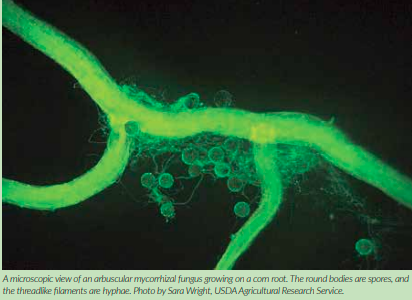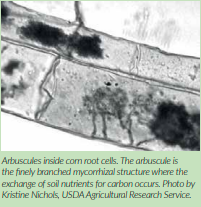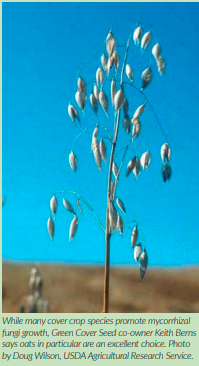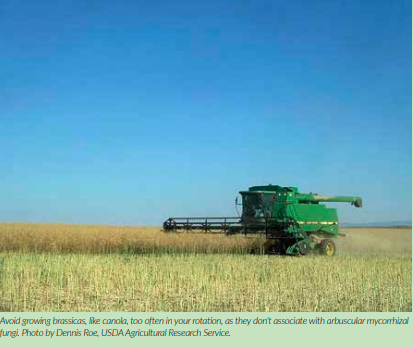Written By Laura Barrera First Published on AGfuse.com
If someone asked you, “How do plants take up the water and nutrients they need?” you’d probably tell
them through the roots. But did you know that for many crops, those roots aren’t working alone?
That’s because most plant species associate with mycorrhizal fungi.
What are mycorrhizal fungi? University of Alberta biological scientist JC Cahill says that mycorrhizas are actually the interaction between a fungus and a plant. Although there are many different types of mycorrhizae, the only one crop farmers need to be concerned about is arbuscular mycorrhizal fungi (AMF), as 65% of plant species associate with it.

And barring anything extreme that’s happened to your fields — such as mining or a toxic spill — your soils should already have AMF in it, says Miranda Hart, a soil microbial ecologist at the University of British Columbia. The way AMF works, Cahill explains, is that they grow inside the plant’s roots, and in exchange for sugar from the plant, the hyphae — the threadlike filaments of the fungi — capture water and nutrients in the soil for the plant. While this symbiotic relationship is often seen and discussed as a benefit to crop production, Cahill and Hart warn that’s not always the case. But there are steps farmers can take to help AMF be more of an advantage than a disadvantage for their crops.
Benefits of Mycorrhizae
One of AMF’s benefits to crops, and perhaps the most significant, is phosphorus uptake.

A study at the University of Adelaide in Australia was conducted to quantify the contribution of AMF to phosphorus uptake in wheat. The researchers used phosphorus 32, a radioactive isotope of phosphorus, and grew the wheat in compartmented pots with highly calcareous and phosphorus-fixing soil from a major cereal-growing area in South Australia. Researchers found that over 50% of phosphorus uptake in plants was absorbed via AMF, and phosphorus 32 was only detected in the AMF plants. In fact, an influx of phosphorus in roots colonized by mycorrhizal fungi can be three to five times higher than in non-mycorrhizal roots, according to the article “Phosphorus Uptake by Plants: From Soil to Cell.” The reason for this is because mycorrhizae allows the plant to explore a greater volume of soil.
The book, “Phosphorus in action – Biological processes in soil phosphorus cycling. Soil Biology Vol. 26,” explains that while root hairs can only extend a few millimeters, the hyphae of some AMF can extend many centimeters away. Alice Roy-Bolduc and Mohamed Hijri, authors of the article “The Use of Mycorrhizae to Enhance Phosphorus Uptake: A Way Out The Phosphorus Crisis,” say that in addition to the larger surface area, phosphorus is also highly immobile and phosphate ions become rapidly bound with cations, making it unavailable to plants. However, they say it is known that the presence of mycorrhizal fungi improves phosphate solubility..
Phosphorus uptake is not the only benefit of AMF. Roy-Bolduc and Hijri say that because they extends the root system, they help absorb more water and can access water in smaller pores, thereby increasing plant water uptake. They also improves soil structure, contribute to soil aggregation and decrease erosion. AMF can also help plants resist and overcome pathogen infections, as the authors note that it’s well-documented that mycorrhizal associations protect tomato plants from Phytophthora parasitica and potato plants from Fusarium sambucinum.
Cahill notes that part of the reason mycorrhizae may help with crop protection is because the AMF are already living in the plant. “They’re actually taking up space that other parasitic fungi can’t then take up themselves,” he explains. “So they may actually help protect crop plants from some soil pathogens by filling up the roots.” The combination of all these benefits ultimately can contribute to higher yields and healthier crops.
When Mycorrhizae Becomes Parasitic
While AMF can provide many benefits for plants, Cahill says that in some situations the relationship can be parasitic. An example of this would be if a plant doesn’t need phosphorus or water. The AMF is still present and taking carbon and sugar from the plant, but not giving anything in return. “So what we see in nature is this relationship between the fungus and the plant goes from beneficial to the crop to detrimental, depending on exact conditions at any point in time,” Cahill explains. It’s important to understand this because farmers can help avoid creating situations that would cause the mycorrhizae to become parasitic.
The best way to prevent a parasitic situation is by ensuring the soil isn’t too fertile, Cahill says. Unfortunately, there’s no measurement established that determines the fine line between when a soil is fertile enough for crops, but not so fertile mycorrhizae becomes parasitic. “One of the reasons there isn’t is because it’s so dependent on what species of fungi you have,” he explains. “There are different levels of parasitism, and different crops are going to be differently able to prevent or not prevent parasitism.” Because phosphorus uptake is the No.1 benefit AMF provide plants, Cahill says that if there’s no evidence of phosphorus limitation in your fields, then you might not need to be concerned about mycorrhizae. He adds that mycorrhizae can also change over time — whether it’s from applying an inoculant or introducing a different crop — the effects of which could be positive or negative.
Testing for Mycorrhizae
Unfortunately, at this time it’s difficult for growers to determine whether their AMF is benefitting their crops or not, Cahill says, because it’s not enough to know whether the plants are infected by mycorrhizae. Instead, it’s a question of whether the plant would do better on its own.
Because phosphorus uptake is the No.1 benefit AMF provide plants, Cahill says that if there’s no evidence of phosphorus limitation in your fields, then you might not need to be concerned about mycorrhizae.
“We want to be very skeptical of anybody pulling up a root system and showing you all of this infection because that’s no big deal,” he explains. “We know, typically, the amount of infection in the roots, the quantity of it, isn’t related to the yield of the plant. It’s more complicated than that. It’s the physiological functioning.”

One way to think about it, Cahill explains, is if a plant is infected with mycorrhizae in a positive way, then we can expect the plant to produce fewer roots because the fungi is doing more foraging for it. If you took the fungi away, then the plant would probably produce more roots. But having more or less roots doesn’t guarantee that the plant would produce more or less yield. “You might not actually see a shift in yield because the plants are outsourcing their foraging to the fungus or doing it themselves, but they’re spending a lot of their energy either way,” Cahill explains. If a grower is seeing unhealthy crops or lower yields than expected, then he can determine if it might be an issue with his mycorrhizae by replicating a test Cahill does in his lab. Growers simply take a little soil from their fields, put into a pot of sterile soil and see how the plants in that pot grow compared to plants grown in just sterile soil. “There’s no measure of fungal biomass that we care about,” he adds. “It simply is, put it on your plants and see what happens.”
Best Practices for Healthy Mycorrhizae
Increase Crop Diversity
The best way farmers can help AMF be beneficial for their crops is by increasing their plant diversity.
“The No. 1 way to increase the diversity of fungi, which will also increase the functioning of the fungi, is to increase plant diversity in agroecosystems,” says Hart. Keith Berns, a farmer, agricultural educator and co-owner of Green Cover Seed in Bladen, Neb., recommends having eight to 10 different species in a cover crop mix, with at least six of them being highly mycorrhizal. Aside from brassicas, which do not associate with AMF, Bern says most cover crops are beneficial for AMF. “It doesn’t mean you couldn’t have brassicas in your mix,” he adds. “You just wouldn’t want to have only those in your mix. Buckwheat is also not really highly mycorrhizal.” Almost all legumes, including peas, lentils, vetch, cowpeas, chickpeas and mung beans, are good for mycorrhizal fungi growth, he says. Grasses like sorghums, millets, rye, triticale, barleys — and oats in particular — are also excellent colonizers. He also likes to see flax and sunflowers in the mix, noting they both have excellent mycorrhizal hosting capabilities.

The reason Berns recommends growing so many different species is because it’ll provide a diversity of root exudates. “There may be different strains of mycorrhizae that will like something better than another one,” Berns says. He adds that it also helps ensure there will be something available to feed the mycorrhizae. “If we have weather conditions that are too hot, too cold, too dry, too wet, that may affect some of the species in the mix, but it’s likely not going to affect everything the same amount,” he explains. “It’s not so much the species as much as having the resiliency built into the system to make sure there’s something growing there, because the one thing that we do know is that having fallow ground is literally death to the mycorrhizae, because they have to have a living host.”
Rotate Brassicas and Maintain Weed Control
Because brassicas don’t associate with AMF, Hart recommends farmers who are growing them space them out in their rotation. “In Canada, because prices are good for canola right now, a lot of farmers are going back to mono-cropping,” she says. “But if you mono-crop brassicaceous crops, you’re going to destroy the fungal communities in a couple years completely, because they need carbon. And if they can’t form it with the crop plant, they’ll eventually become extinct in that site.” Hart says that having a brassica in rotation with at least two other crops would be ideal. But for growers who are in a two-crop rotation where one is a brassica, they need to look at ways of getting other plant species in their soil, such as through intercropping or cover crops.
The reason Berns recommends growing so many different species is because it’ll provide a diversity of root exudates.
Brassicas aren’t the only species that don’t associate with AMF. Some weeds, such as lambsquarters and pigweed, are also non-mycorrhizal — another reason why preventing and controlling weed infestations like palmer amaranth is so important. “Whatever plants become dominant in a field, be they crop or weed, we know that changes the composition of the organisms that live in the soil,” Cahill says. “So if you have a plant that doesn’t form mycorrhizae becoming very dominant, those fungi in the soil are likely to become a little bit starved and those populations are likely to go down.”
Reduce Tillage
One practice growers will want to reduce or avoid when trying to promote healthy mycorrhizal fungi and soil biology is tillage. “Tilling is terrible for fungal communities. It destroys the mycelium,” Hart says. “Some fungi can handle it, but some fungi really can’t and they’ll disappear. So you’re going to decrease diversity by tilling.” Cahill agrees, noting that tillage often contributes to soil compaction, which is also detrimental to soil life. “When you have really compacted soil, we know that impacts water penetration and can impose drought, but it also doesn’t give the air spaces and pockets that all these fungi, bacteria and even nematodes and other things need to live,” he explains. “So you need to keep that soil light, which is typically done through no-till.” However, Hart warns that no-tilling often increases a farmer’s herbicide use, which could also negatively impact fungi. But there are some no-tillers like Russell Hedrick andGabe Brown who are successfully no-tilling with fewer herbicide applications by implementing a holistic, systems’ approach.
Be Mindful of Fungicides, Fertilizers
Farmers also need to be mindful of the products they apply if they want to promote AMF growth. “Fungicides will kill fungi, and many of them will kill mycorrhizal fungi,” Cahill says, adding that if you’re concerned that a fungicide may have a negative effect on the soil life, you should test it. This can be done by putting some soil from your field into a couple pots, applying fungicide to one, then growing plants in both and seeing what happens. Growers should also be mindful of fertilizers, Cahill adds, as they often impose some acidity. And as soil pH decreases, it will kill off a lot of fungi and other soil organisms. “Fungi seem to be really sensitive to change in the acidity of soil and salt contents,” he says.
Should You Use Inoculants?
If you’re growing a perennial like alfalfa or a crop that’s going to be there for 10 years, then applying an inoculant may provide a jumpstart for AMF, says Berns. “With a perennial you have no fallow period breaks, so that’s where the mycorrhizae really shine because they never have to jump from one host to another,” he says, adding that it can be harder to justify the cost of an inoculant on an annual crop. But Berns has done some testing with these products on his farm, and has observed some differences between plots treated with inoculants vs. the control plots, particularly with aboveground growth and root mass. This year he put a lot on his corn and soybean acres and is waiting to see if they made any difference.
Cahill encourages all farmers to do as Berns has and become scientists on their own farms, “because they’ll be able to see with their own eyes whether it does or doesn’t have an effect.” He also recommends growers test these products before applying it to their whole fields by again testing them in pots. Farmers can do this by growing some plants in a pot of sterile soil with the inoculant and some in a pot without the inoculant, and seeing if there’s a yield difference.
Growers should also be mindful of fertilizers, Cahill adds, as they often impose some acidity. And as soil pH decreases, it will kill off a lot of fungi and other soil organisms.
The reason he wants growers to do some small trials first is because there’s no widespread evidence these products are beneficial all the time, and if a parasitic inoculant establishes in a field, there’s no easy way to remove it. In fact, he tells his students every year that the one thing he wants them to remember from his class is to not let their moms buy a bag of inoculum from the garden store and just apply it to their gardens. “She’s most likely paying to put parasites on her garden,” he says. “Until you can prove it works in that garden, it’s not worth the money.” He says to think of mycorrhizal inoculants like fertilizer. “We know that adding fertilizer doesn’t always increase crop yield because there are going to be some farms and conditions that have enough fertilizer, or you get toxicity,” he explains. “That’s going to happen with inoculum too.
There are going to be some situations where they’re not beneficial and they might be parasitic, but we don’t know if they are yet.” Hart agrees with Cahill that there’s no guarantee the effect of an inoculant will be beneficial. In fact, she says that the particular isolate being mass commercialized actually depresses phosphorus uptake. “A plant without that fungus is getting more phosphorus than the plant with the fungus,” she explains. “They’re not always mutualistic in every situation. Sometimes, depending on the soil nutrients, the plant and the growth stage, they will actually suppress plant growth and performance.”
But Hart says that in most cases, the inoculant is probably not even establishing. She recalls a 2-year field trial where the commercial inoculant only established in one out of 4 farms. “Where it established, it established quickly and it spread fast,” she says. “But in the other plots, it would’ve been a waste of money for the farmers to use it.” She’s also concerned about the effects these products may have on non-target species, pointing out that there have been studies where this particular fungus has occluded every other fungus in the community. The studies were short-term, Hart says, so it’s too early to make generalizations about it. But she says she can’t in good conscience tell farmers they should be using these products because we don’t know the dangers yet.
Grow Native Species
Instead, Hart recommends growers focus on promoting the mycorrhizal fungi populations already in their fields by trying to grow plants that are native to the land — whether it be through cash crops, intercropping or cover crops — so the mycorrhizal fungi and all of the soil microbes become more diverse, sustainable, and ultimately, more functional. “You want to make it as close as possible to what was original before the land was tilled,” she says. “Because native plants and fungi have evolved together, so they are more likely more beneficial for each other.”
